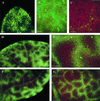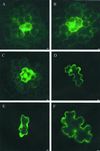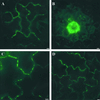Non-targeted and targeted protein movement through plasmodesmata in leaves in different developmental and physiological states
- PMID: 11299360
- PMCID: PMC88836
- DOI: 10.1104/pp.125.4.1802
Non-targeted and targeted protein movement through plasmodesmata in leaves in different developmental and physiological states
Abstract
Plant cells rely on plasmodesmata for intercellular transport of small signaling molecules as well as larger informational macromolecules such as proteins. A green fluorescent protein (GFP) reporter and low-pressure microprojectile bombardment were used to quantify the degree of symplastic continuity between cells of the leaf at different developmental stages and under different growth conditions. Plasmodesmata were observed to be closed to the transport of GFP or dilated to allow the traffic of GFP. In sink leaves, between 34% and 67% of the cells transport GFP (27 kD), and between 30% and 46% of the cells transport double GFP (54 kD). In leaves in transition transport was reduced; between 21% and 46% and between 2% and 9% of cells transport single and double GFP, respectively. Thus, leaf age dramatically affects the ability of cells to exchange proteins nonselectively. Further, the number of cells allowing GFP or double GFP movement was sensitive to growth conditions because greenhouse-grown plants exhibited higher diffusion rates than culture-grown plants. These studies reveal that leaf cell plasmodesmata are dynamic and do not have a set size exclusion limit. We also examined targeted movement of the movement protein of tobacco mosaic virus fused to GFP, P30::GFP. This 58-kD fusion protein localizes to plasmodesmata, consistently transits from up to 78% of transfected cells, and was not sensitive to developmental age or growth conditions. The relative number of cells containing dilated plasmodesmata varies between different species of tobacco, with Nicotiana clevelandii exhibiting greater diffusion of proteins than Nicotiana tabacum.
Figures





References
-
- Atkins D, Hull R, Wells B, Roberts K, Moore P, Beachy RN. The tobacco mosaic virus 30K movement protein in transgenic tobacco plants is localized to plasmodesmata. J Gen Virol. 1991;72:209–211. - PubMed
-
- Citovsky V, Knorr D, Schuster G, Zambryski P. The P30 movement protein of tobacco mosaic virus is a single-strand nucleic acid binding protein. Cell. 1990;60:637–647. - PubMed
Publication types
MeSH terms
Substances
Grants and funding
LinkOut - more resources
Full Text Sources

